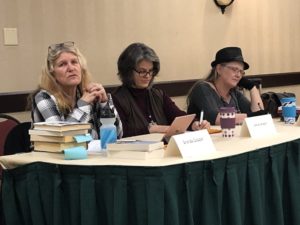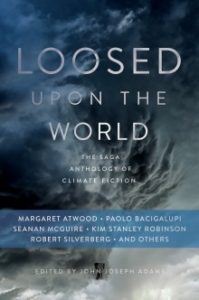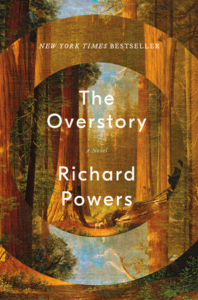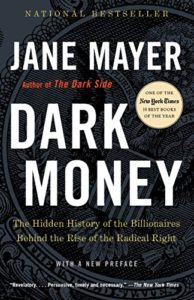This past weekend was Orycon, our wonderful local science fiction, fantasy, and horror convention. As usual, I got to attend and present at some terrific panels, hang out with lots of amazing human beings, do some serious Christmas shopping, and go to some fun parties.
One of the highlights of the convention turned out to be the panel “Must-reads for the Environmentally Aware.” I came with a short list of books and short stories I wanted to share, and my fellow panelists–two writers I really admire, Brenda Cooper and Joyce Reynolds-Ward–brought their own extensive lists. I was writing as quickly as I could to collect all the great recommendations!

Photo by Curtis Chen.
Needless to say, everyone was eager to get a copy of the final list, so I decided to type it up and share it here. If you’re looking for something terrific to read, give one of these a try.
Short stories
All three of us occasionally write short fiction, and Brenda and I both greatly enjoy reading the stuff. Here are few short stories, collections, and anthologies we couldn’t stop raving about:
“An Incomplete Timeline of What We Tried,” by Debbie Urbanski. Terraform. A fabulous–and crushing–list story that wrestles with climate change. (SF)
“Spring Thaw,” by Charles Payseur. Nightmare Magazine. A former snow plow driver applies his skills on an Antarctic expedition. (SF/horror)
“Hot Rods,” by Cat Sparks. Lightspeed Magazine. Car racing after climate change. (SF)
Reckoning. A magazine/anthology series devoted to environmental justice. All genres.
Damnation Alley, a climate/apocalyptic novella by Roger Zelazny from 1967. Adapted into apparently a not-so-good novel and a not-so-good film.
Dancing in Dreamtime, by Scott Russell Sanders. Best known for his essays, Sanders started as a science fiction writer, and this collection showcases his short work. (SF)
Drowned Worlds, edited by Jonathan Strahan. An anthology of short fiction about water issues after climate change. One standout in this one is “Venice Drowned,” by Kim Stanley Robinson. (SF)
 Loosed Upon the World, edited by John Joseph Adams. An anthology of climate change fiction with a lot of heavy hitters. (SF)
Loosed Upon the World, edited by John Joseph Adams. An anthology of climate change fiction with a lot of heavy hitters. (SF)
John Joseph Adams’ anthology series–Wastelands and Wastelands 2–is focused on apocalyptic fiction, but many of those stories contain environmental elements. (SF)
I’m With the Bears, edited by Mark Martin. An anthology of climate fiction by literary giants like David Mitchell and Margaret Atwood. (SF)
The Year Without a Winter, edited by Dehlia Hannah. Stories, essays, and art exploring climate change. With a story from Brenda Cooper! (SF + more)
Novels
Environmental themes can make for terrific reading in a novel! We had many suggestions. I wrote down summaries when I could.
 The Overstory, by Richard Powers. If you read only one novel from this list, this should probably be the one. Amazing writing and a terrific melding of literary and speculative techniques. Plus, some of it is set in the Pacific Northwest! (literary)
The Overstory, by Richard Powers. If you read only one novel from this list, this should probably be the one. Amazing writing and a terrific melding of literary and speculative techniques. Plus, some of it is set in the Pacific Northwest! (literary)
Arctic Rising, by Tobias Buckell. The first in a series of SF eco-thrillers. (SF)
NK Jemisin’s The Broken Earth series. If you haven’t read it yet, why not? Get yourself to a bookstore or the library and get going!
New York 2140, by Kim Stanley Robinson. What will New York City look like when the oceans rise? Another well-researched novel from KSR; possibly linked to his “Venice Drowned” short story. (SF)
Blackfish Rising, by Sam J. Miller. Political corruption in a floating Arctic city, set after “the climate wars.” (SF)
Who Fears Death, by Nnedi Okorafor. It’s post-apocalyptic and it’s gonna be a tv show. (SF)
Annihilation, by Jeff Vandermeer. The whole Southern Reach trilogy is definitely a must-read for anyone with an interest in the environment–as if Jeff Vandermeer’s Twitter stream! (SF)
Good News, by Edward Abbey. Did you know Edward Abbey wrote a science fiction novel? Neither did I!
Water Rites, by Mary Rosenblum. An Oregon SF writer writing about water scarcity in the west. (SF)
The Water Knife, by Paolo Bacigalupi. (SF)
The Queen of the Tearling, by Erika Johansen. The first in a YA fantasy series that seems purely fantastical … at first. (YA, fantasy with SF elements)
Flight Behavior, by Barbara Kingsolver. (literary)
Stand on Zanzibar, by John Brunner. Climate fiction from the 1960s. (SF)
The Drowned World, by JG Ballard. The world floods in this climate classic from 1962. (SF)
Time of the Great Freeze, by Robert Silverberg. What if the Earth froze? Disaster novel from 1964.
Nonfiction
 Dark Money, by Jane Mayer. If you read one piece of nonfiction, this one might be the most important. How did oil money conquer democracy?
Dark Money, by Jane Mayer. If you read one piece of nonfiction, this one might be the most important. How did oil money conquer democracy?
Half-Earth, by E.O. Wilson. What if we set aside half the planet for non-human beings? — FEEL GOOD
Going Green: True Tales from Gleaners, Scavengers, and Dumpster Divers, edited by Laura Pritchett. Essays for the thrifty green.
Young Men and Fire, by Norman McClean. Wildfire is the new normal in the west–here’s a book that digs into one big bad fire and the people who fought it.
The More Beautiful World Our Hearts Know Is Possible, by Charles Eisenstein. What can we do to help the Earth? The whole book is available to read online. — FEEL GOOD
Saving Tarboo Creek, by Scott Freeman. The story of one family’s part in restoring a NW salmon stream. — FEEL GOOD
The Hidden Life of Trees, by Peter Wohlleben. Dudes. Trees are waaaay cooler than you ever thought. Read this book. Then go hug your arboreal friends. — FEEL GOOD
The Soil Will Save Us, by Kristin Ohlson. The subtitle says it all: “How scientists, farmers, and foodies are healing the soil to save the planet.” — FEEL GOOD
The Devil’s Highway, by Luis Alberto Urrea. An analysis of what crossing the US-Mexico border really means.
The God Species, by Mark Lynas. How do we save the planet … from ourselves?
The Sixth Extinction, by Elizabeth Kolbert. How humanity became the biggest driver of biodiversity loss since the Chicxulub asteroid.
Holdfast: At Home in the Natural World, by Kathleen Dean Moore. Essays by a fine naturalist and philosopher.
The Pine Island Paradox, by Kathleen Dean Moore. How nature and the human spirit are blended.
Feral, by George Monbiot. In some places, rewilding efforts are making amazing strides in improving plant and animal diversity.